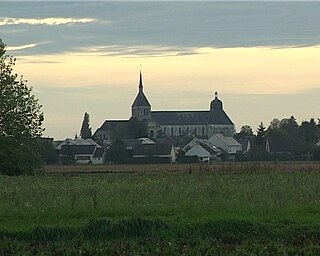Related Research Articles

Robert II, called the Pious or the Wise, was King of the Franks from 996 to 1031, the second from the Capetian dynasty. Crowned Junior King in 987, he assisted his father on military matters. His solid education, provided by Gerbert of Aurillac in Reims, allowed him to deal with religious questions of which he quickly became the guarantor. Continuing the political work of his father, after becoming sole ruler in 996, he managed to maintain the alliance with the Duchy of Normandy and the County of Anjou and thus was able to contain the ambitions of Count Odo II of Blois.

Jacques Grévin was a French playwright.

Saint-Benoît-sur-Loire is a commune in the Loiret department in north-central France.

Fleury Abbey (Floriacum) in Saint-Benoît-sur-Loire, Loiret, France, founded in about 640, is one of the most celebrated Benedictine monasteries of Western Europe, and possesses the relics of St. Benedict of Nursia. Its site on the banks of the Loire has always made it easily accessible from Orléans, a center of culture unbroken since Roman times. In 2010, the abbey had over forty monks led by the abbot Etienne Ricaud.

Henri de Boulainvilliers was a French nobleman, writer and historian. He was educated at the College of Juilly; he served in the army until 1697.

The Diocese of Autun (–Chalon-sur-Saône–Mâcon–Cluny), more simply known as the Diocese of Autun, is a Latin Church diocese of the Catholic Church in France. The diocese comprises the entire Department of Saone et Loire, in the Region of Bourgogne.

Jean Paul Louis François Édouard Leuge-Dulaurier was a French Orientalist, Armenian studies scholar and Egyptologist.
Odorannus of Sens was a Benedictine monk at the abbey of Saint-Pierre-le-Vif in Sens, France. He was, in varying capacities, an artist, architect, goldsmith, musical theorist, biographer, exegete and chronicler.

The Île Barbe is an island situated in the middle of the Saône, in the 9th arrondissement de Lyon, the quartier Saint-Rambert-l'Île-Barbe. Its name comes from the Latin insula barbara, "Barbarians' Island", suggesting that it was one of the last locales to be occupied.

Robert Arnauld d’Andilly was a French conseiller d’État, specialising in financial questions, in the court of Marie de' Medici. By the elegance of his language, he was among the major poets, writers and translators of 17th century French classicism. A fervent Catholic, he played an important role in the history of Jansenism and was one of the Solitaires of Port-Royal-des-Champs. He was also renowned for his part in the development of the pruning of fruit trees, to which he was devoted.
Natalis de Wailly was a French archivist, librarian and historian.

Robert-Henri Bautier was a French historian, archivist, and medievalist. He was elected a member of the Royal Academy of Science, Letters and Fine Arts of Belgium in 1986.

Casimir Freschot was a French historian, chronicler and translator. He was the author of about fifty works, both in French, Italian and Latin on various historical and contemporary subjects, the most notable being Li pregi della Nobiltà Veneta abbozzati in un giuoco d'arme, published in Venice in 1682, Origine, progressi e ruina del calvinismo nella Francia, ragguaglio istorico di D. Casimiro Freschot, published in 1693, and Histoire du congrès et de la paix d'Utrecht - par C. Freschot, published in 1716.

Édouard Fournier was a French homme de lettres, playwright, historian, bibliographer and librarian.

Aimé Vingtrinier was a French printer, writer, amateur historian, figure of the 19th-century scholar.
Jules François Toutain was a French archeologist.
Louis Demaison was a 19th–20th-century French historiographer, archaeologist, and with Henri Jadart, one of the most significant contributors to the nineteenth/twentieth history of the Marne department.
Olivier Guyotjeannin is a French medievalist and diplomatist.

Georges Poisson was a French art historian.

Henri Leclercq was a French Catholic priest, theologian, and church historian who spent most of his adult life in the United Kingdom.
References
- This article incorporates text from a publication now in the public domain : Chisholm, Hugh, ed. (1911). "Helgaud". Encyclopædia Britannica . Vol. 13 (11th ed.). Cambridge University Press. p. 220. which in turn cites:
- Histoire littéraire de la France , VII (Paris, 1865–1869).
- Auguste Molinier, Les Sources de l'histoire de France, II (Paris, 1902).